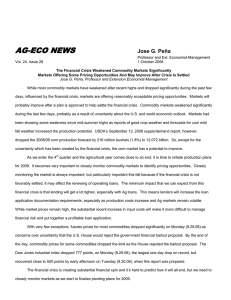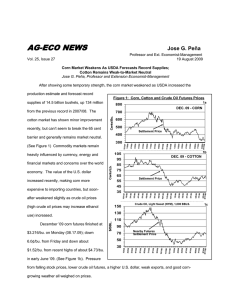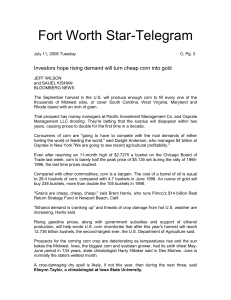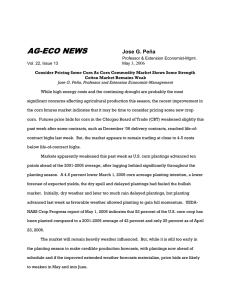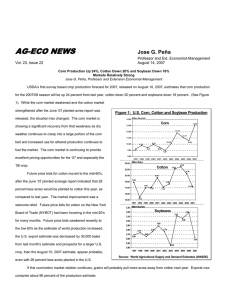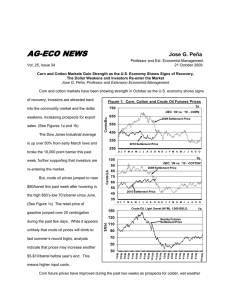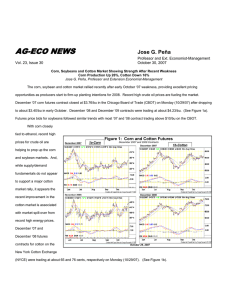AG-ECONEWS EXTENSION AgriLIFE ~e~~
advertisement
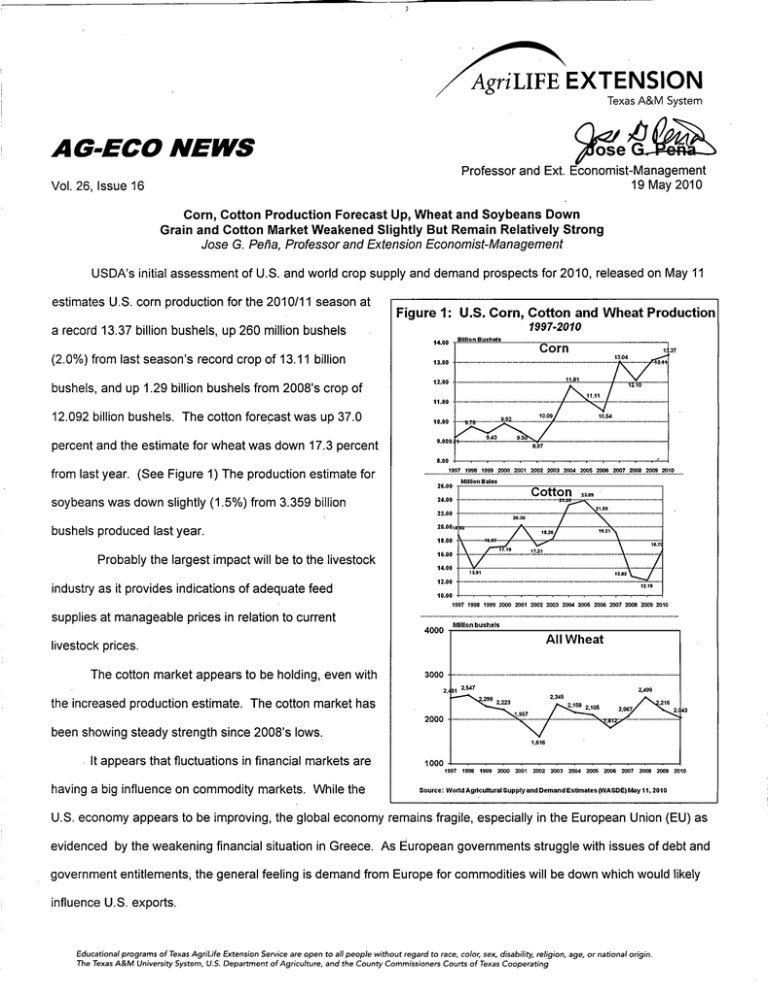
AgriLIFE EXTENSION Texas A&M System AG-ECONEWS ~e~~ Professor and Ext. Economist-Management 19 May 2010 Vol. 26, Issue 16 Corn, Cotton Production Forecast Up, Wheat and Soybeans Down Grain and Cotton Market Weakened Slightly But Remain Relatively Strong Jose G. PeF1a,Professor and Extension Economist-Management USDA's initial assessment of U.S. and worl.d crop supply and demand prospects for 2010, released on May 11 estimates U.S. corn production for the 2010/11 season at a record 13.37 billion bushels, up 260 million bushels Figure 1: U.S. Corn, Cotton and Wheat Production 1997.2010 Billion Bushels (2.0%) from last season's record crop of 13.11 billion bushels, and up 1.29 billion bushels from 2008's crop of 12.092 billion bushels. The cotton forecast was up 37.0 percent and the estimate for wheat was down 17.3 percent 8.00 ..... ~.~!~~ !~.~~ from last year. (See Figure 1) The production estimate for soybeans was down slightly (1.5%) from 3.359 billion 24.00 ~~ ~~ ~.Q!?~ .._~--~.~ ..~~ ?!!!!.!. ~ ~ ~~~ . Million Bales 26.00 Cotton ----------:---------.-n-,25-.- ".•• ---------- 22.00 bushels produced last year. 18.00 Probably the largest impact will be to the livestock industry as it provides indications of adequate feed 16.00 14.00 12.00 12.1' 10.00 1997 1998 1999 2000 2001 2002 2003 2004 2005 2006 2007 2008 2009 2010 supplies at manageable prices in relation to current 4000 Millionbushels All Wheat livestock prices. The cotton market appears to be holding, even with 3000 .--.-------.-----------2, the increased production estimate. 1 2,547 2,499 The cotton market has 2000 been showing steady strength since 2008's lows. 1,616 . It appears that fluctuations in financial markets are 1000 1997 1998 1999 2000 2001 2002 2003 2004 2005 2006 2007 2008 2009 2010 having a big influence on commodity markets. While the Source: World Agricultural Supply and Demand Estimates (WASDE) May ii, 2010 U.S. economy appears to be improving, the global economy remains fragile, especially in the European Union (EU) as evidenced by the weakening financial situation in Greece. As European governments struggle with issues of debt and government entitlements, the general feeling is demand from Europe for commodities will be down which would likely influence U.S. exports. Educational programs of Texas AgriUfe Extension Service are open to all people without regard to race, color, sex, disability, religion, age, or national origin. The Texas A&M University System, U.S. Department of Agriculture, and the County Commissioners Courts of Texas Cooperating USDA's record corn production forecast is based on increased planted acres and higher yields. These factors and an accelerated pace of planting are increasing the potential for high crop yields and may account for the weakening of grain markets during the past few months. USDA-NASS Crop Progress report of May 17, 2010 indicated that 87 percent of the corn had been planted compared to a five-year average of 78 percent and 55 percent of the corn crop has emerged compared to a five-year average of 39 percent. Forty-seven percent of the cotton crop has been planted compared to a five year average of 46 percent. What is the market offering? While the potential for volatile price movements in commodity markets remains, especially in grain markets, it appears that commodity markets are starting to settle down after the past two years of wide volatility. Even as volatile price swings continue in the stock market, such as with the Dow Jones Industrials Index which recently lost and gained close to 1,000 points during two days of trading, it appears that consumer confidence is being regained and is providing some stability to commodity markets. Figure 2: Corn, Cotton and Wheat Futures Prices But accelerated crop progress, reports of a 500 potential excellent harvest in South America, a stronger U.S. dollar, volatile oil and stock prices, 450 ::i III <;;400 C ell and serious concerns for the economic situation in 0350 Settlement !.. prices to three week lows. Near-by corn futures on 800 $3.60/bu.) and December corn is down about 15 JULY '10 • WHEAT 750 the Chicago Board of Trade (CBOT) are down about 10 cents since the beginning of May ($3.71/bu. to Price 300 the European Union (EU) pressured corn futures 700 ,650 Iil 600 ~ 550 I: ~ 500 450 cents for the same time period ($3.95/bu. to 400 !g~~~~~~g~l!lgl!l~~~~ ~ ;!~~~ii~~lii;~;~~ii .. ~ ~ ~ $3.80/bu.). it ~ "............................... 80 Wheat futures on the Kansas City Board of 7S Trade (KBOT) have been trading sideways-to- 70 :@65 slightly lower of late after dropping 25 cents/bu. from early May (5.13/bu. to $4.88/bu.). III ~60 0 55 so While futures prices for new crop cotton dropped 2.5 cents a pound from recent highs of ..II B ~ , I I I I ~ ii ~ 0 I IiI ..5I ..I ..iiiI ..i 0 0 'I: 'I: 0 'I: iii ~ ~ 0 i ii about 78 cents a pound, prices for cotton have been showing a steady improvement for over two years after months of trading around the loan rate. After recent highs of about 78 cents/lb, Dec. '10 cotton futures prices dropped to about 75.5 cents a pound but were back up to close at about 77.42 cents/lb on Monday (5.17.10). It appears that new crops future prices are meeting resistance at about 78 cents/lb. Corn-SID USDA's May 11 supply-demand report estimated new crop production at a record 13.37 billion bushels, up 2.0 percent from last year. The projected average yield at 163.5 bu./ac. was 1.2 bushels below last season's record average yields of 164.7 bu./ac., but the estimate of acres for harvest at 81.6 million acres was up 2.2 million acres from 79.6 million acres harvested last year. While the beginning stock estimate was reduced slightly from last month's estimate, at 1.738 billion bushels, beginning stocks are up 65 million bushels from last year, bringing the estimate of total supplies to a record 15.118 billion bushels, up 2.2 percent from last year's supplies of 14.793 billion bushels. Domestic corn feed and residual use was reduced slightly with a slow recovery in animal numbers and increased use of distiller's grains. The estimate of total use for ethanol production was increased by 200 million bushels. Corn ethanol use, projected at 4.6 billion bushels, is supported by rising Federal biofuels mandates and strong blending incentives that continue to boost ethanol usage. Biofuel use now accounts for about 34.4 percent of the corn production estimate and continues to fuel the grain market. Exports are projected up 2.6 percent, as lower prices are attracting exports, especially to China. But, according to USDA, rising foreign feed grain supplies, mostly corn, may limit export growth in 2010/11. U.S. corn ending stocks for 2010/11 are projected at 1.8 billion bushels, up 4.6 percent from last year. Globally, coarse grain production is projected at a reford 1;129.8 million tons, up two percent from 2009/10. Most of the 27.4-million-ton increase in coarse grains production is coming from foreign corn production. But, global corn consumption is projected at a record high 827.9 million tons, up 19.0 million tons from 2009/10, with nearly threequarters of the increase consumption in foreign markets. World corn ending stocks are projected at 154.2 million tons, up 7.2 million from 2009/10, the highest since 2000/01 and may dampen the prospects for U.S. exports. USDA projected the season-average farm price at $3.20 to $3.80 per bushel, compared with the 2009/10 forecast of $3.50 to $3.70 per bushel. Cotton-SID The cotton market has been showing a steady improvement for the past two years after months of trading at or below the loan rate. The price outlook for 2010/11 is heavily dependent on a global economic recovery as about 81 percent of the new crop production estimate is pegged as export bound. USDA's first new crop production estimate, based on trend yields and the March 31, 2010 cotton planting intentions, indicated higher supplies offset by higher exports relative to last season, resulting in marginally lower ending stocks. Production is projected at 16.7 million bales, up about 37 percent from last year, but combined with 51.1 percent lower beginning stocks, the estim~te of supplies are up just 6.8 percent from last season. projected at 3.3 million bales, a marginal reduction from 2009/10. Domestic mill use is Exports are projected to rise 1.5 million bales from 2009/10 to 13.5 million, as foreign demand is expected to outpace supply. Ending stocks are projected at 3.0 million bales, the lowest since 1995/96. World cotton production is projected to rise nearly 11 million bales in 2010/11, but supplies will increase just slightly from last season as the estimate of beginning stocks was down 9.94 million bales from last year. USDA estimates that the average price received by producers will range from 60 to 74 cents per pound. Appreciation is expressed to Dr. Mark Welch, Ext. Economist-Grain Marketing for his contribution to and review of this article.

